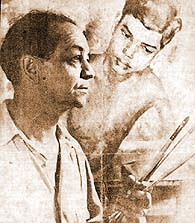A browning photo of David Paynter holding paintbrushes, looking away from the camera.
“Having studied art for some time in Italy and France, I found that the painters there had painted their own countries and their own times. So I decided to paint in the way I did, with more or less Ceylon landscapes and more or less Ceylonese types. Besides, I intensely disliked many of the paintings of comparatively recent times where Christ has been portrayed as a blond Englishman and wearing Arab costume”
— David Paynter
David Paynter was an internationally renowned Sri Lankan artist raised on a Christian mission; his religious upbringing would influence him and his work throughout his life. His paintings were exhibited at the Royal Academy for nearly twenty years, from 1923 to 1940. Though now remembered primarily for his Biblical scenes, he also painted portraits, focusing on labourers and people outside of the Sri Lankan upper class. He is remembered equally for his work and for the scandal surrounding it.
David Shillingford Paynter was born in 1900 to Arthur Stephen Paynter, a British missionary, and Anagi Weerasooriyaa, a Sinhalese woman from southern Sri Lanka. The two met while working for the Salvation Army and, in fact, left to start the India Christian Mission. Anagi was pursued by so many coworkers that she sent a letter to the Salvation Army HQ in England saying: “Please do not send any more unmarried Majors to Ceylon!”
Eva Darling, Paynter’s sister, wrote of her parent’s marriage, saying “[Anagi’s] mother was unhappy about her marriage to a foreigner.” Anagi’s father, David Weerasooriya, “always like this black-haired, blue-eyed, Cornish man with his definitive and strong views.”
The two would later go on to found Nuwara Eliya Children’s Home, where they welcomed children who often had mixed or unknown parentage. The project still exists today as The Paynter Home. The website describes it by saying:
“There are Christians, Hindus, Muslims, and Buddhists. None of the children or staff make any distinction about religion or race. They all relate very well together with genuine affection, the children appear to have a good relationship with all the adults and address them with a prefix Uncle and Aunty. The staffs appear to be able to speak both Sinhala, Tamil quite fluently and most understand English and some speak it. Sri Lanka and the world is torn apart by religious and ethnic conflict, and here in this little community is an example of people living and working together. Surely, this is a micro model of what we would like the whole Island, the world to be. This is a very valuable and rare set of circumstances and we should celebrate it. It is interesting to note in passing that this set of circumstances is not the outcome of implementation of any policy or ideology. It has evolved organically.”
Paynter grew up in this environment and went on to attend Trinity College before receiving a five-year scholarship to the Royal Academy. It was there that he won the Gold Metal for Art and the Edward Stott Travelling Scholarship, leading him to study for two weeks in Italy. While there, he began to find influences for his paintings, deeply inspired by the Christian work of the Renaissance. Albert Dharmasiri writes of this influence, saying, “Paynter had found in Italy that the work of her painters was consonant with the spirit of their time and place.”
Paynter later wrote of his time in Italy:
“Having studied art for some time in Italy and France, I found that the painters there had painted their own countries and their own times. So I decided to paint in the way I did, with more or less Ceylon landscapes and more or less Ceylonese types. Besides, I intensely disliked many of the paintings of comparatively recent times where Christ has been portrayed as a blond Englishman and wearing Arab costume”
Upon his return, he was commissioned to paint murals in the Trinity College chapel, and it was there that he painted what is arguably his most famous piece. In 1935, he revealed his work depicting well-known Christian stories now set in Ceylon. Perhaps the most well-known piece is his depiction of the crucifixion, in which Christ is portrayed as a dark-skinned man with Ceylonese imagery around him.
Though this is by far his most recognized work, he was also a renowned portrait artist and continued to depict Biblical scenes. He was particularly interested in the male form, and his portraits included the likes of British Governors and Prime Ministers of Sri Lanka.
Much of his work focused on male beauty, with nudes and semi-nudes the most prevalent. Though there are no written works or speeches about his queerness, his friends and colleagues spoke of him being openly queer. His art and his participation in an almost exclusively queer group of anti-fascist artists called Group 43, as well as his lack of interest in women or marriage, make it clear that he was likely queer.
Paynter more or less retired from art to focus on social work, opening the Salt Spring Farm at Kumburupiddi in 1962 to settle boys from The Paynter Home. He eventually moved there, permanently settling as a farmer.
In 1968, he finished one of his final pieces, and in 1975 passed away due to a heart attack. His sister Eva Darling was left with the entirety of his work. She went on to tell his story, as well as the story of her family, in a biography. She worked tirelessly to fulfil her brother’s wishes.
It was his final wishes that led him into the spotlight once again. Paynter had willed his work not to be sold but rather donated to the University of the Visual and Performing Arts. In 2015, it was discovered that the professor entrusted with keeping the late artist’s nineteen paintings had sold them. All but one of the pieces have been recovered, though many were damaged.
Despite that hiccup, David Paynter is in a unique position in that his legacy honours his life well. With the help of his sister, a few individuals at the University of the Visual and Performing Arts, and perhaps even the art thief, Paynter is remembered fondly. Donald Ramanayeka, another Sri Lankan artist, spoke of Paynter and his artistic influence at length, but he represented Paynter best in a short quote:
“David Paynter was a gentle person. Full of humanity. He was politeness personified.”
[Disclaimer: some of the sources may contain triggering material]
Aldrich, R. (2014). Cultural Encounters and Homoeroticism in Sri Lanka: Sex and Serendipity. Abingdon, UK: Routledge.
Ammon, R. (2010). Gay Sri Lanka News & Reports 2008-11. Retrieved from https://archive.globalgayz.com/asia/sri-lanka/gay-sri-lanka-news-and-reports-2008/
David Paynter. (n.d.). Retrieved from http://www.artnet.com/artists/david-paynter/
De Soysa, R. (2016). The ‘43 Group. Retrieved from http://thenationaltrust.lk/wp-content/uploads/2018/06/The-43-Group.pdf
Finally, a home for Paynter’s paintings. (n.d.). The Sunday Times. Retrieved from http://www.sundaytimes.lk/180513/plus/finally-a-home-for-paynters-paintings-293503.html
Kappagoda, D. B. T. (2017). Art of David Paynter. Daily News. http://www.dailynews.lk/2017/02/01/features/106293/art-david-paynter
Kuruwita, S. (2014). David Shillingford Paynter: ‘Paynter the Painter.’ Retrieved from http://trinitylk.com/2014/09/david-shillingford-paynter-paynter-the-painter/
Paynter, David. (n.d.). Retrieved from https://www.artceylon.com/artist40.html
Weerasooriya, R. (2016). The Paynter Behind Some Of Sri Lanka’s Finest Art. Roar Media. Retrieved from https://roar.media/english/life/culture-identities/the-paynter-behind-some-of-sri-lankas-finest-art/
Robinson, L.R. (1989). An Interview with Donald Ramanayeka on Aspects of Culture in Sri Lanka. Nagasaki University. Retrieved from http://hdl.handle.net/10069/26128



